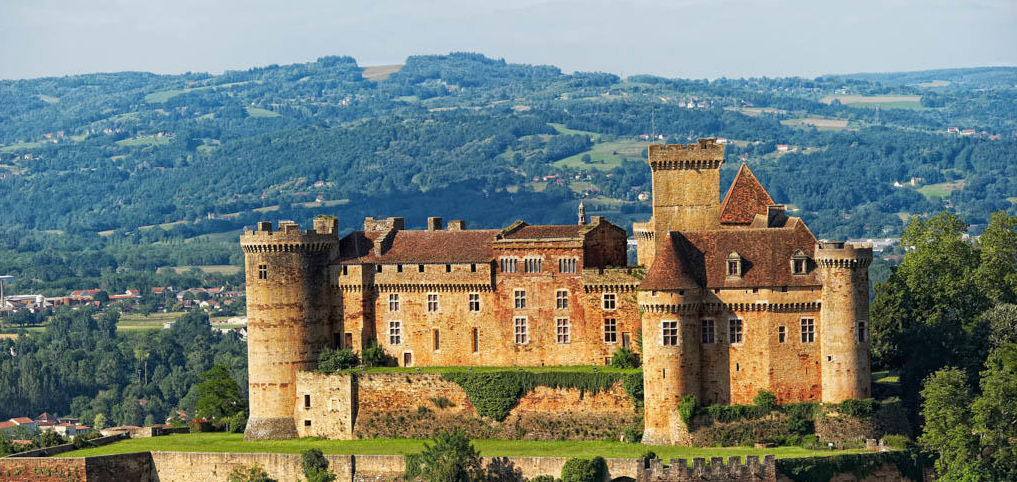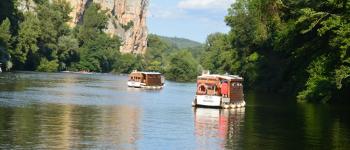
Prosper Mérimée said that this castle "is a summary of the arts of the Middle Ages."
We are at the end of a rocky plateau overlooking the land of the four rivers, Cère, Bave, Mamoul and Dordogne, on the northern edge of the Quercy region and 25 km from Rocamadour.
Another writer, Pierre Loti, described it as follows: "serration of blood-coloured stone".
A bit of History...
Mentioned in the cartulary of the Abbey of Beaulieu sur Dordogne from the 8th century, the barony asserted itself with the construction of the first new castle in 1100, by Hugues, then Gerbert, then Gerbert II who was Bishop of Cahors.
After bitter feudal struggles with the Turenne, the Castelnau obtained to raise directly from the Kings of France in 1280 (Philippe II the Bold, then Philippe IV the Beautiful in 1308).
Castelnau was then a strategic place, and it is in the 13th century that were built the tower-residence and the keep, of red and ochre stone, which still dominate the site.
This family will then experience a strong rise, first by its alliance with the Calmont d'Olt, lords of Espalion and Saint-Côme en Rouergue, then by the marriage of Hugues de Castelnau with the niece of Pope John XXII at the beginning of the 14th century, and finally in the 15th century with the Caylus.
In 1530, the heiress of the Castelnau-Caylus family brought the barony to the Clermont-Lodève family.
In 1715, the succession fell to the Baroness Jeanne d'Albert de Luynes, then to the Dukes of Luynes in 1756. The Luynes will finally sell the castle and land in 1830.
The initial constructions were completed throughout the 14th, 15th and 16th centuries.
The castle then acquired its almost definitive configuration, with the addition of three main buildings flanked by towers, supplemented by a powerful artillery tower, the whole protected by a low wall and ditches.
A third enclosure surrounded the entire village, of which a fortified gate and some remains remain.
The east and north dwellings, added in the 15th century, close the inner courtyard and give the whole its triangular plan.
At the end of the 16th century, following the evolution of techniques, casemates equipped with shooting chambers and bastions with square "à la française" gunboats reinforced the lining of the towers and the curtain walls, making it very difficult to approach the castle.
The Clermont-Lodève family, in particular Alexandre, carried out major works throughout the 17th century, transforming the austere fortified castle into a luxurious residence, with wide openings, a large balcony of honour opening onto the valley, and a large gallery with arcades where parties were held, which the poet François de Maynard and the Toulouse Capitouls were regulars.
Their descendants lost interest in Castelnau, preferring their Parisian hotel and their castle in Clermont (Clermont l'Hérault today), although their possessions in Quercy continued to provide them with baskets of truffles, as provided for in the farm leases as late as 1782.
Amputated of the defences of the châtelet and drawbridge in 1793, partially dismantled and looted from its archives, the castle avoided total demolition in 1844 thanks to the intervention of the Prefect of the Lot, and Inspector Calvet, the recent Commission of Historic Monuments.
Then a fire ravaged it at the beginning of 1851.
Jean Mouliérat, the saviour
Classified as a historical monument in 1862, the ruined castle was finally bought back in 1896 by the man who was going to save it, Jean Mouliérat, tenor of the Opéra-Comique de Paris.
He devoted his fortune and energy to raising the castle, restoring and fitting out the interior, as well as furnishing it. He assembled an important and very diverse collection of furniture, paintings, tapestries, statuary and objets d'art from all periods, as well as a remarkable lapidary deposit.
Jean Mouliérat, artist, art lover and humanist, received in Castelnau Rodin, Colette, great names of the political and cultural life, as well as the last queen of Madagascar, Ranavalo.
He died in 1932, after having, with the assistance of his friend Minister Anatole de Monzie, donated the castle and collections to the State.
According to his wishes, the apartments we visit today display all the furniture and objets d'art in the layout he himself had chosen.
Castle of Castelnau-Bretenoux
Castelnau,
46130 Prudhomat
Tel. : 05 65 10 98 00
http://www.castelnau-bretenoux.fr/
Translated with www.DeepL.com/Translator
(free version)






